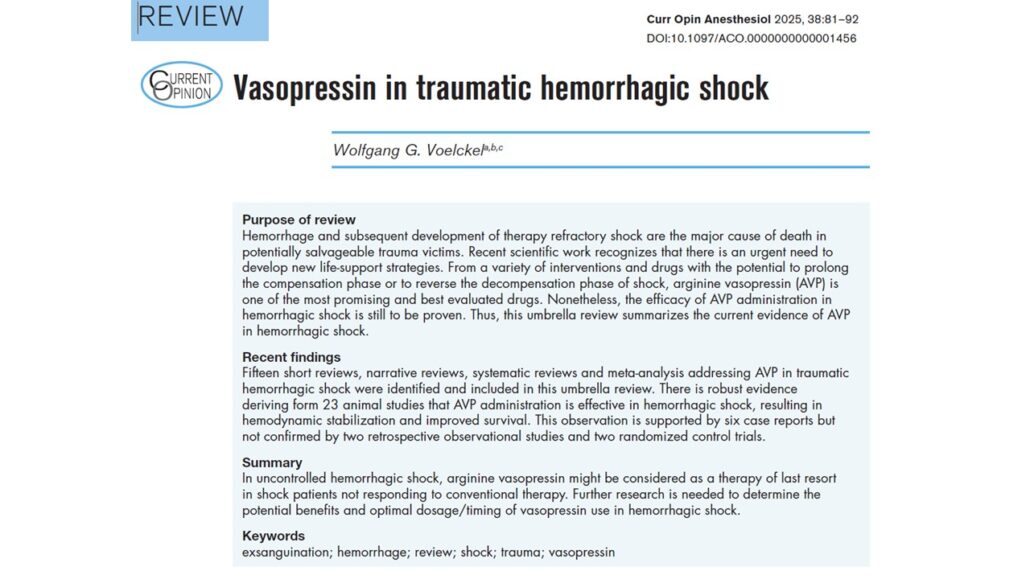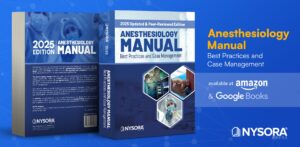
Vasopressin in traumatic hemorrhagic shock: A promising but unproven therapy
Traumatic hemorrhagic shock remains a leading cause of death in trauma patients, particularly when fluid resuscitation fails and surgical intervention is delayed. Despite advancements in trauma care, effective strategies for stabilizing patients in hemorrhagic shock remain elusive. One emerging treatment option is arginine vasopressin (AVP), a potent vasoconstrictor promising in experimental models. However, its clinical efficacy is still under debate. The review by Voelckel et al. 2025 explores the role of vasopressin in traumatic hemorrhagic shock, summarizing current research, potential benefits, and remaining uncertainties.
Understanding hemorrhagic shock
Hemorrhagic shock results from severe blood loss, leading to decreased venous return, reduced cardiac output, and impaired oxygen delivery to tissues. If untreated, it can progress to irreversible shock and death.
Key physiological responses to hemorrhagic shock include:
- Baroreceptor activation releases catecholamine (epinephrine, norepinephrine) to maintain blood pressure.
- Vasoconstriction to preserve blood flow to vital organs (heart, brain).
- Activation of the renin-angiotensin-aldosterone system (RAAS) to conserve fluid.
However, when these compensatory mechanisms fail, patients develop vasoplegia, which is characterized by severe hypotension and inadequate perfusion. This is where vasopressin may play a role.
Mechanism of vasopressin in hemorrhagic shock
Vasopressin, an endogenous hormone, is released in response to hypotension and hypovolemia. It exerts its effects by:
- Increasing systemic vascular resistance through V1 receptor activation leads to vasoconstriction.
- Shifting blood flow from peripheral circulation (skeletal muscle, cutaneous, and splanchnic regions) to vital organs (heart and brain).
- Enhancing fluid retention via V2 receptor activation in the kidneys, improving intravascular volume.
Studies show that AVP remains effective even in late-stage shock, unlike norepinephrine and angiotensin II, which lose their vasoconstrictive properties due to excessive nitric oxide production.
Research findings on vasopressin in traumatic hemorrhagic shock
Animal studies
- 23 animal studies confirm that vasopressin can stabilize hemodynamics and improve survival rates in hemorrhagic shock.
- Vasopressin administration in pigs and rodents resulted in:
- Increased arterial pressure
- Decreased fluid requirements
- Prolonged survival
Clinical evidence
- Case Reports: Six case reports suggest AVP effectively restored hemodynamics in patients with fluid and catecholamine-refractory shock.
- Observational Studies:
- Two retrospective studies failed to show a survival benefit in AVP-treated patients.
- One prospective cohort study found no statistically significant mortality difference.
- Randomized Controlled Trials (RCTs):
- Two RCTs examined vasopressin in trauma patients:
- One trial found reduced fluid requirements but no survival benefit.
- Another reported no significant improvement in outcomes.
- Two RCTs examined vasopressin in trauma patients:
When should vasopressin be used?
Despite promising animal data, the timing and dosage of vasopressin in hemorrhagic shock remain unclear.
- Early administration: Controversial due to concerns about reducing tissue perfusion before bleeding is controlled.
- As a last resort: Considered in catecholamine-refractory shock when fluid resuscitation and transfusions fail.
- Hypovolemic cardiac arrest: Some reports suggest AVP may help restore circulation in cardiac arrest due to severe blood loss.
Risks and limitations of vasopressin
While vasopressin shows potential, serious adverse effects limit its routine use:
- Severe vasoconstriction can cause:
- Ischemia in the gastrointestinal tract, leading to bowel necrosis.
- Peripheral ischemia, resulting in tissue damage or necrosis.
- Cardiac complications:
- Myocardial ischemia or infarction due to excessive vasoconstriction.
- Arrhythmias, including ventricular tachycardia and asystole.
- Lack of human data:
- Most evidence comes from animal models.
- Limited high-quality clinical trials make recommending AVP as a standard therapy difficult.
Current trauma guidelines and casopressin
- The European Trauma Guidelines (6th edition) recommend norepinephrine for maintaining arterial pressure in hypotensive trauma patients but do not endorse vasopressin due to insufficient evidence.
- ATLS (Advanced Trauma Life Support) and other major trauma guidelines do not recommend vasopressors as first-line therapy in hemorrhagic shock.
- Instead, fluid resuscitation, blood transfusions, and early hemorrhage control remain the mainstay of treatment.
Conclusion
- Experimental models strongly support using vasopressin in hemorrhagic shock, but clinical trials do not yet confirm a survival benefit.
- Vasopressin may be considered as a last-resort therapy in catecholamine-resistant shock, but routine use is not currently recommended.
- Future research should focus on:
- Optimal dosing strategies.
- Best timing of administration.
- Long-term safety in trauma patients.
For now, vasopressin remains an intriguing but unproven tool in the management of hemorrhagic shock. More well-designed, large-scale clinical trials are needed to determine its definitive role in trauma resuscitation.
For more information, refer to the full article in Current Opinion in Anesthesiology.
Voelckel WG. Vasopressin in traumatic hemorrhagic shock. Curr Opin Anaesthesiol. 2025 Apr 1;38(2):81-92.
Read more about perioperative bleeding in our Anesthesiology Manual: Best Practices & Case Management.




